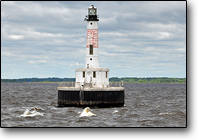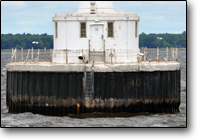Historical Information
While
Peshtigo Point could easily be seen jutting into Green Bay to the east
of the Peshtigo River entrance, what could not be seen was the
treacherous reef which extended some three miles beyond the offshore
end of the point. With depths of only one to six feet above its rocky
bottom, Peshtigo Reef represented a serious threat to maritime
interests making their way in and out of southern Green Bay.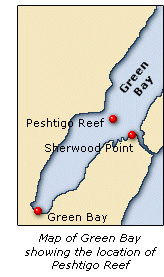 Responding
to the rapidly burgeoning maritime traffic in the area, the Lighthouse
Board dispatched a special committee to Green Bay in 1865 to analyze
the situation and recommend the best location for aids to navigation in
the area. After touring the area and meeting with various maritime
interests, the committee reported that lights were desperately needed
on Chambers Island, Peshtigo Shoal and on Grassy Island at the mouth of
the Fox River. Congress responded to the Board's subsequent
recommendation on July 28, 1866 with an appropriation of $25,000 for
the construction of the three light stations. However, with the
completion of the Chambers Island station in 1867, the remainder of the
appropriation was withdrawn, and the possibility of constructing lights
on Peshtigo Reef was put on indefinite hold.Without
the necessary funds to construct a lighted station, the District
Inspector was forced to seek alternate methods of marking the hazard,
and to this end the perimeter of the reef closest to the river was
marked with four spar buoys later that same year. In 1869, this
arrangement was augmented with the construction of a daymark at the
offshore end of the reef, consisting of a thirty foot square wooden
crib surmounted with a wooden pyramidal structure topped by an iron
cage. While these aids served the needs of daytime navigation, they
were clearly of little use to mariners making their way through the
area during the dark of night or in the thick fogs that frequently
blanketed the area. Seeking to provide a more permanent solution to
meet the ever increasing number of vessels making their way into the
ports of Sturgeon Bay and Green Bay, the Lighthouse Board again
recommended that the sum of $10,000 be appropriated for the
construction of a light station and fog signal to mark the reef in its
1892 annual report.While
Congress affirmed the need for a light with the passage of an act
approving the station's construction on February 15, 1893, they
neglected to follow-up with the necessary appropriation. After
reiterating its request for funds in its report the following year, the
Board appears to have dropped the subject until 1898, when deciding
that the winter ice which packed the area represented too great a
threat to a permanent structure, they instead recommended that $15,000
be appropriated for the construction of a lightship to be placed on the
reef. Congress turned a deaf ear to the request until June 28, 1902
when the necessary funds for the light vessel were finally appropriated. Responding
to the rapidly burgeoning maritime traffic in the area, the Lighthouse
Board dispatched a special committee to Green Bay in 1865 to analyze
the situation and recommend the best location for aids to navigation in
the area. After touring the area and meeting with various maritime
interests, the committee reported that lights were desperately needed
on Chambers Island, Peshtigo Shoal and on Grassy Island at the mouth of
the Fox River. Congress responded to the Board's subsequent
recommendation on July 28, 1866 with an appropriation of $25,000 for
the construction of the three light stations. However, with the
completion of the Chambers Island station in 1867, the remainder of the
appropriation was withdrawn, and the possibility of constructing lights
on Peshtigo Reef was put on indefinite hold.Without
the necessary funds to construct a lighted station, the District
Inspector was forced to seek alternate methods of marking the hazard,
and to this end the perimeter of the reef closest to the river was
marked with four spar buoys later that same year. In 1869, this
arrangement was augmented with the construction of a daymark at the
offshore end of the reef, consisting of a thirty foot square wooden
crib surmounted with a wooden pyramidal structure topped by an iron
cage. While these aids served the needs of daytime navigation, they
were clearly of little use to mariners making their way through the
area during the dark of night or in the thick fogs that frequently
blanketed the area. Seeking to provide a more permanent solution to
meet the ever increasing number of vessels making their way into the
ports of Sturgeon Bay and Green Bay, the Lighthouse Board again
recommended that the sum of $10,000 be appropriated for the
construction of a light station and fog signal to mark the reef in its
1892 annual report.While
Congress affirmed the need for a light with the passage of an act
approving the station's construction on February 15, 1893, they
neglected to follow-up with the necessary appropriation. After
reiterating its request for funds in its report the following year, the
Board appears to have dropped the subject until 1898, when deciding
that the winter ice which packed the area represented too great a
threat to a permanent structure, they instead recommended that $15,000
be appropriated for the construction of a lightship to be placed on the
reef. Congress turned a deaf ear to the request until June 28, 1902
when the necessary funds for the light vessel were finally appropriated.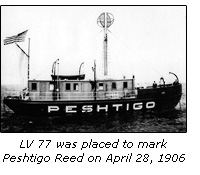 Responding
to the appropriation, the District Engineer in Milwaukee immediately
drew-up plans and specifications for the vessel, and awarded a contract
for its construction that same year. However, the after the contractor
failed to commence work on the vessel within the allotted time period,
the contract was rescinded and bids were again advertised in 1903. A
new contract was awarded to the Johnson Boiler Company in Ferrysburg
Michigan, with the vessel's keel being laid early in 1904.Designated
as LV77, the specifications called out a steel hulled vessel built in
the "scow style." At 75 feet in length, with a beam of 21 feet 7
inches, she was to draw 9 feet 3 inches and displace 110 tons. With
crew accommodations consisted of four staterooms, a head and galley,
she was to be equipped with a hollow steel lantern mast around which a
ring of three oil lens-lanterns could be raised and lowered from her
main deck. To keep costs to a minimum she was designed without any
propulsion system, and was thus to be towed on and off station by the
lighthouse Dahlia or Hyacinth. To further reduce costs she was equipped
with a hand-operated fog bell and on-board storage space to hold a
years' supply of food and oil for the lanterns, so that she could
remain on station for the entire navigation season without requiring
re-supply.Work
on the vessel was completed late in 1905, and the contractors delivered
her to her to her winter quarters in Sturgeon Bay in November of that
same year. Too late to be placed on the reef, she was finally towed to
her station on Peshtigo Reef, and her Master Peter Knudsen exhibited
the vessels lanterns for the first time on the night of April 28, 1906.
She remained on station without incident during each navigation season
over the following five years until August 18, 1911 when to the joy of
her crew she was towed into Sturgeon Bay for the installation of an air
operated 8 inch chime whistle, and returned to her station on September
16. Responding
to the appropriation, the District Engineer in Milwaukee immediately
drew-up plans and specifications for the vessel, and awarded a contract
for its construction that same year. However, the after the contractor
failed to commence work on the vessel within the allotted time period,
the contract was rescinded and bids were again advertised in 1903. A
new contract was awarded to the Johnson Boiler Company in Ferrysburg
Michigan, with the vessel's keel being laid early in 1904.Designated
as LV77, the specifications called out a steel hulled vessel built in
the "scow style." At 75 feet in length, with a beam of 21 feet 7
inches, she was to draw 9 feet 3 inches and displace 110 tons. With
crew accommodations consisted of four staterooms, a head and galley,
she was to be equipped with a hollow steel lantern mast around which a
ring of three oil lens-lanterns could be raised and lowered from her
main deck. To keep costs to a minimum she was designed without any
propulsion system, and was thus to be towed on and off station by the
lighthouse Dahlia or Hyacinth. To further reduce costs she was equipped
with a hand-operated fog bell and on-board storage space to hold a
years' supply of food and oil for the lanterns, so that she could
remain on station for the entire navigation season without requiring
re-supply.Work
on the vessel was completed late in 1905, and the contractors delivered
her to her to her winter quarters in Sturgeon Bay in November of that
same year. Too late to be placed on the reef, she was finally towed to
her station on Peshtigo Reef, and her Master Peter Knudsen exhibited
the vessels lanterns for the first time on the night of April 28, 1906.
She remained on station without incident during each navigation season
over the following five years until August 18, 1911 when to the joy of
her crew she was towed into Sturgeon Bay for the installation of an air
operated 8 inch chime whistle, and returned to her station on September
16.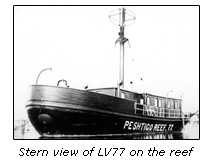 By
the 1930's, the constant pounding of the lake had taken its toll on the
vessel, and seeking to further reduce ongoing costs of operation, the
Lighthouse Service determined the combination of improvements in
offshore construction techniques and improvements in electrical and
mechanical systems would allow the construction of a virtually
automated tight station on Peshtigo Reef.In
September 1934, a work party arrived at the offshore end of Peshtigo
Reef to begin construction of a wooden crib to serve as the foundation
of the new station. By the onslaught of winter, work on the crib was
competed, and the work party abandoned the site to the ravages of
winter. Returning in the spring of the following year, and finding the
crib to be in satisfactory condition after its winter in the ice, work
tuned to the construction of the pier atop the crib foundation. By
the 1930's, the constant pounding of the lake had taken its toll on the
vessel, and seeking to further reduce ongoing costs of operation, the
Lighthouse Service determined the combination of improvements in
offshore construction techniques and improvements in electrical and
mechanical systems would allow the construction of a virtually
automated tight station on Peshtigo Reef.In
September 1934, a work party arrived at the offshore end of Peshtigo
Reef to begin construction of a wooden crib to serve as the foundation
of the new station. By the onslaught of winter, work on the crib was
competed, and the work party abandoned the site to the ravages of
winter. Returning in the spring of the following year, and finding the
crib to be in satisfactory condition after its winter in the ice, work
tuned to the construction of the pier atop the crib foundation.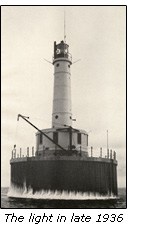 Plans
for the new pier were unique, taking advantage of recent advancements
in design and steel technology. A fifty foot ring of sheet piling was
first installed atop the crib to serve as the exterior form for the
foundation pier. Within this outer ring, five six-foot diameter steel
cylinders were placed, with a group of wooden piles driven into the
center of each. All remaining spaces within the central cylinders and
the outer ring were then filled with concrete to a level 8 feet six
inches from the upper edge of the sheet piling. A solid slab of
concrete was then poured atop the cylinders, and carefully floated and
leveled to serve as the floor of the basement within the pier. Forms
were then constructed on this floor to create a central machinery room
and concentric storage areas within the pier and the top of the sheet
piling was covered with a heavy slab of concrete to serve double-duty
as both basement ceiling and as the pier's top deck.With
the completion of the pier, a temporary light and fog signal were
established on the night of August 26, 1935, and no longer needed on
the reef was removed from her station and towed into Sturgeon Bay.
Subsequently, she was assigned to relief duty throughout the Great
Lakes. Plans
for the new pier were unique, taking advantage of recent advancements
in design and steel technology. A fifty foot ring of sheet piling was
first installed atop the crib to serve as the exterior form for the
foundation pier. Within this outer ring, five six-foot diameter steel
cylinders were placed, with a group of wooden piles driven into the
center of each. All remaining spaces within the central cylinders and
the outer ring were then filled with concrete to a level 8 feet six
inches from the upper edge of the sheet piling. A solid slab of
concrete was then poured atop the cylinders, and carefully floated and
leveled to serve as the floor of the basement within the pier. Forms
were then constructed on this floor to create a central machinery room
and concentric storage areas within the pier and the top of the sheet
piling was covered with a heavy slab of concrete to serve double-duty
as both basement ceiling and as the pier's top deck.With
the completion of the pier, a temporary light and fog signal were
established on the night of August 26, 1935, and no longer needed on
the reef was removed from her station and towed into Sturgeon Bay.
Subsequently, she was assigned to relief duty throughout the Great
Lakes.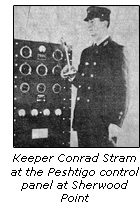 Work
then turned to the circular steel structure 25 feet in diameter and 14
feet I height located on the center of the pier deck. While the station
was designed to be semi automatic, and thus would not require full time
keepers, this structure was divided into two rooms as living quarters
in the event that keepers servicing the station from Sherwood Point
lighthouse station became marooned during their service and supply
trips. Centered on this main structure, a steel plate tower containing
a cast iron spiral staircase supported a cast iron lantern with
horizontal astragals housing a Fourth Order Fresnel lens. With the
completion of work on the superstructure, everything above the crib
deck was given a coat of cream-colored paint, with the exception of the
lantern, which was painted black to help serve as a daymark against the
sky.The
station obtained its power from a gasoline engine and 110-volt
generator located in the basement machinery room. Hooked to a 110-volt
storage battery, the battery was constantly maintained in a state of
charge by the generator to serve as a backup in case of engine or
generator failure. An electric bulb within the Fourth Order lens output
20,000 candlepower, and in combination with the station's 72-foot focal
plane provided a sixteen mile range of visibility in clear weather. The
station was also equipped with a 200 mm flashing white winter lens,
which was activated every December 1st, and emitted a characteristic
single half-second flash every five seconds. Work
then turned to the circular steel structure 25 feet in diameter and 14
feet I height located on the center of the pier deck. While the station
was designed to be semi automatic, and thus would not require full time
keepers, this structure was divided into two rooms as living quarters
in the event that keepers servicing the station from Sherwood Point
lighthouse station became marooned during their service and supply
trips. Centered on this main structure, a steel plate tower containing
a cast iron spiral staircase supported a cast iron lantern with
horizontal astragals housing a Fourth Order Fresnel lens. With the
completion of work on the superstructure, everything above the crib
deck was given a coat of cream-colored paint, with the exception of the
lantern, which was painted black to help serve as a daymark against the
sky.The
station obtained its power from a gasoline engine and 110-volt
generator located in the basement machinery room. Hooked to a 110-volt
storage battery, the battery was constantly maintained in a state of
charge by the generator to serve as a backup in case of engine or
generator failure. An electric bulb within the Fourth Order lens output
20,000 candlepower, and in combination with the station's 72-foot focal
plane provided a sixteen mile range of visibility in clear weather. The
station was also equipped with a 200 mm flashing white winter lens,
which was activated every December 1st, and emitted a characteristic
single half-second flash every five seconds.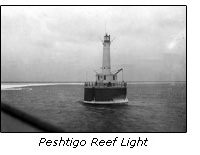 The
station's fog signal consisted of an air operated diaphragm powered by
a compressor, also driven by the gasoline engine. While the light was
controlled automatically, the fog signal was radio controlled by the
keepers at the Sherwood Point Light station located eight miles to the
southeast. Once activated from Sherwood Point, the fog signal would
automatically emit its characteristic single two-second blast every 20
seconds. The station was also equipped with a solenoid operated fog
bell which continuously struck one blow of the bell every 20 seconds
regardless of the weather, in case a radio control system malfunction
prevented the keepers from activating the diaphragm signal.The
work was completed, and the station first exhibited in June 1936. The
Sherwood Point keepers serviced the light with a small wooden launch
powered by a gasoline engine, and were responsible for ensuring that
the equipment was functioning properly, and ensuring that the gasoline
supply tanks in the crib were kept full.After
having faithfully served maritime interests throughout the district for
thirty-five years, LV77 was retired from lighthouse duty at the end of
the 1939 navigation season, and sold into private ownership in April of
the following year. The
station's fog signal consisted of an air operated diaphragm powered by
a compressor, also driven by the gasoline engine. While the light was
controlled automatically, the fog signal was radio controlled by the
keepers at the Sherwood Point Light station located eight miles to the
southeast. Once activated from Sherwood Point, the fog signal would
automatically emit its characteristic single two-second blast every 20
seconds. The station was also equipped with a solenoid operated fog
bell which continuously struck one blow of the bell every 20 seconds
regardless of the weather, in case a radio control system malfunction
prevented the keepers from activating the diaphragm signal.The
work was completed, and the station first exhibited in June 1936. The
Sherwood Point keepers serviced the light with a small wooden launch
powered by a gasoline engine, and were responsible for ensuring that
the equipment was functioning properly, and ensuring that the gasoline
supply tanks in the crib were kept full.After
having faithfully served maritime interests throughout the district for
thirty-five years, LV77 was retired from lighthouse duty at the end of
the 1939 navigation season, and sold into private ownership in April of
the following year.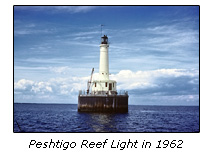 At
an as yet undetermined point in time, a submarine power cable was run
to the station, and no longer needed, the gasoline engine and
generators were shut down and removed from the crib. The fog signal was
automated, and the Sherwood Point keeper's were relieved of
responsibility for the offshore station. Also, at some time between
1962 and the present, the tower received a distinctive painted red
horizontal band to increase its effectiveness as a daymark. Over
65 years later, Peshtigo Reef Light still stands faithful guard over
the reef, and while the volume of commercial maritime traffic making
its way into the head of Green Bay has reduced significantly over the
years, she still serves as a welcome beacon to the huge amount of
pleasure craft which ply the waters of Green Bay. At
an as yet undetermined point in time, a submarine power cable was run
to the station, and no longer needed, the gasoline engine and
generators were shut down and removed from the crib. The fog signal was
automated, and the Sherwood Point keeper's were relieved of
responsibility for the offshore station. Also, at some time between
1962 and the present, the tower received a distinctive painted red
horizontal band to increase its effectiveness as a daymark. Over
65 years later, Peshtigo Reef Light still stands faithful guard over
the reef, and while the volume of commercial maritime traffic making
its way into the head of Green Bay has reduced significantly over the
years, she still serves as a welcome beacon to the huge amount of
pleasure craft which ply the waters of Green Bay.

Seeing
this Light

Since
this light is too far out in Green
Bay to be seen well from shore, the only way to get a
decent view of this light is by private or charter boat.
GPS
Coordinates: 44°57'22.66"N x 87°34'45.31"W
Reference sources Annual report of the Lighthouse Board, various
Door County Advocate newspaper, various
Ironwood Daily Globe newspaper, various
Annual report of the Lake Carriers Association, various
Oschkosh Daily Northwester newspaper, various
Great Lakes Light List, various
Lighships and Lightship Stations of the United States, Willard Flint, 1989
|
